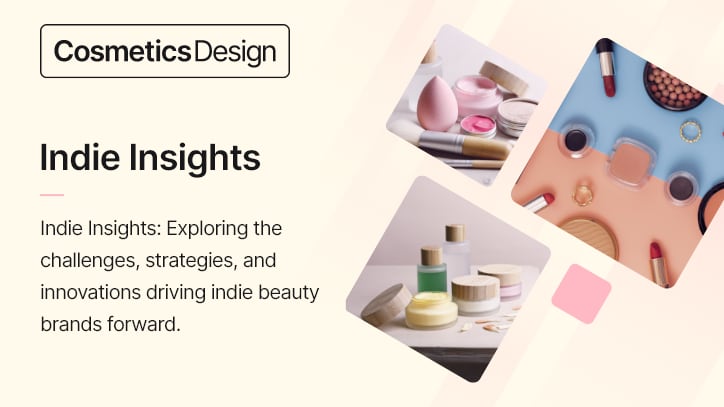As the ingestible beauty market climbs toward a projected $12–$14.5 billion by 2033, as reported by market research firm InsightAce Analytics, brands are racing to differentiate themselves with science-backed formulas and verifiable sustainability.
Bend Beauty is among the indie players navigating this space, focusing on marine-sourced collagen and complementary nutrients to improve skin health. In this month’s Indie Insights, CosmeticsDesign spoke to founder Marc St‑Onge, who discusses the company’s innovation strategy, ingredient sourcing, and how education remains central to consumer adoption.
CDU: Your formulations include marine-sourced ingredients like fish collagen and omega-3. How do these work together to support your inside-out beauty philosophy?
Marc St‑Onge (MSG): At Bend Beauty, we start with the science of the skin. The science of peptides in cosmetic formulations is advancing, and some of the most effective peptides are those found in marine collagen.
Peptides from collagen stimulate dermal fibroblasts to produce more collagen, elastin, and hyaluronic acid—restoring the skin’s firmness, hydration, and resilience. Omega-3 fatty acids, sourced from fish, reduce inflammation, strengthen the skin barrier, reduce UV sensitivity, and improve moisture retention.
We combined these marine ingredients with other synergistic ingredients and co-factors to deliver benefits to skin health, protection against UV and pollutants, and visible signs of aging.
CDU: Sustainability is a big part of Bend Beauty’s DNA. What are some of the most impactful sustainability initiatives you’ve implemented so far?
Marc St‑Onge (MSO): Sustainability guides every decision we make. We source collagen exclusively from wild-caught fish that are certified sustainable by the Marine Stewardship Council.
As compared to the more commonly used bovine collagen, which has a very high carbon footprint and is processed using hard chemicals, our marine collagen has a very small carbon footprint and is efficiently processed using enzymes. Our packaging refresh is another milestone—transitioning to lightweight pouches for certain products, reducing our carbon footprint while improving consumer convenience.
Finally, as a company, we operate on 100% renewable green energy, purchase carbon credits, and commit 1% of all sales to environmental non-profits, ensuring our growth directly supports the health of our planet.
CDU: Collagen is a competitive category. How do you communicate the difference between Bend Beauty’s products and others in the market?
Marc St‑Onge (MSO):
We focus on three pillars of differentiation:
- Evidence-Based Science: All formulations are backed by peer-reviewed research, and we continue to invest in new research.
- Essential Co-Factors: Our collagen isn’t just peptides. We include co-factors such as organic acerola cherry (vitamin C) and bamboo-derived silicon—nutrients essential for collagen crosslinking, strength, and resiliency, while also providing benefits such as healthier looking hair and stronger nails.
- Sustainable Sourcing: We use wild marine ingredients from certified sustainable fisheries, we use organic ingredients when possible (including flavor ingredients) offering consumers confidence in both efficacy and environmental integrity.
This combination of science, formulation sophistication, and sustainability clearly sets us apart.
CDU: What strategies have been most effective in educating consumers about the benefits of ingestible beauty products?
Marc St‑Onge (MSO): Education begins with simplification. We use relatable concepts like the ‘skin climate’ to explain how internal factors such as inflammation, free radicals, drive the balance between skin breakdown and repair.
Sampling programs, professional education for estheticians and wellness practitioners, use of before & afters, and partnerships with thought leaders help us build trust.
Finally, our use of storytelling through social and digital platforms— connecting the dots between lifestyle, science, and sustainability—has been powerful in showing consumers that ingestible beauty, is not a trend, but a long-term solution that can delivered very impactful results for your skin.
CDU: How do you see sustainability shaping the future of the ingestible beauty sector over the next five years?
Marc St‑Onge (MSO): Consumers increasingly expect proof, not promises. Over the next five years, sustainability will move beyond marketing claims to measurable impact, from ingredient sourcing transparency to lifecycle carbon accounting.
Brands that thrive will be those that integrate eco-responsibility into every aspect of product development, while also validating product performance with credible science. Certifications such as B Corp, Organic, and 1% for the Planet will become essential tools for brands to build trust with consumers.
The future will belong to companies that can authentically merge sustainable practices with product performance.
CDU: What advice would you give to other indie brands looking to merge sustainability commitments with high-performance product development?
Marc St‑Onge (MSO): Start with clarity of purpose—sustainability cannot be an afterthought. Build it into your supply chain, packaging, and operations from the very beginning.
At the same time, don’t compromise on performance: the product has to deliver results, because effectiveness builds long-term trust. Partner with suppliers who share your values, and communicate with transparency—even if you’re not perfect yet.
Consumers appreciate honesty, progress, and authenticity over perfection. Most importantly, remember that sustainability is not a cost—it’s an investment in resilience, relevance, and leadership for the future.


